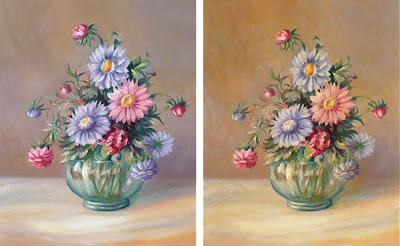His mother had bought the elaborately framed art piece on her honeymoon, and she had left it to him when she passed away. But a family member recently decided it needed cleaning with a damp rag. Hmm. That did not work out very well as you can see below:
Ouch! Poor print. The entire background was obliterated except at the edges which were concealed by the frame. Most of the color, detail and contrasts in the flowers and vase were washed out as well. This was very distressing because the print had great sentimental value as you can imagine.
My mission was to do a new painting of this piece to restore the colors and detail to its former beauty. A little tricky considering what I was working from.
This was my first attempt:
Though my client liked it, he said the vase should be clear and the flowers more detailed and not as soft. This was not a problem - I like detail! I added more detail and contrast and made the vase a clear green. He is happy with this... almost:
There is one more problem. His print looked old because it had a yellowed cast giving an overall golden tone to all the colors and he wants that look. I'd never heard of antiquing a new painting (furniture, yes!) and was a little unsure of how to proceed. Googling this topic brought up nothing.
This is when it's nice to have friends. I checked with a friend of mine, Jack White, who is a master oil painter. This is what he said:
"First the original was warm and more yellow because the varnish had become darker and yellower. This traditionally happens in older paintings...What he wants is an antique painting done today."Though he said it was impossible to paint the aging that my client thought he remembered, he did give me some tips on how to go about getting a more yellowed look overall using a glaze of raw sienna.
I discussed this with my client who agreed. So I let the painting dry thoroughly:
Here's the painting, just sitting and waiting for the final glaze
After about a week, it is ready for the glaze. I mix a tiny bit of raw sienna oil paint with a lot of Liquin. The Liquin is more flexible than oil paint alone, so the thin glaze over the other oils will flex as the oils underneath cure. This will help prevent crackling of the surface.
I use a very soft brush and small strokes to brush this mixture on over the entire painting:
After letting it dry for a bit, here is what we have:
The painting now has a shinier surface and a more golden tone overall. Here is a before and after:
It's not a huge difference, but being the lover of color that I am, I could not bear to do more and the client is happy with it, so all is good! :) Here's what he said:
"You've done a fine job! I'm sure that's as close to the original as anyone could ever get. Thanks so much for all your patience and co-operation; I can't wait to see the painting reframed once more"Hopefully he'll send a photo when it's framed so I can see it too.
----------------------------------------------------
I'm happy to take custom orders! Contact me for a custom painting or to have a print made of a painting you like.
To receive my posts by email, fill in your email address under FOLLOW BY EMAIL in the right hand column and click Submit. You'll receive my posts in your email inbox at the end of each day that a post is made.










No comments:
Post a Comment